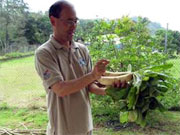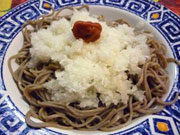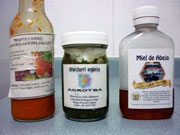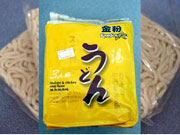Project News
2010-11-23
"Cooking our own meals" – Tri-part essay
Currently there are 3 Japanese experts in Panama assigned to the Alhajuela Project. One lives in an apartment, and the other 2 live in hotels with kitchen facilities in their room. For meals we often go out to eat, but we also know how to cook our own meals.
<The case of Mr. Mori>
In my case, I am living alone in Panama, but I keep a healthy diet by using the farm produce I buy from, or am given by, the farmer groups participating in the Project activities. One time, I was given organic, non-pesticide, white radishes ("daikon"). (Photo 1) I thought, "What about cooking them with fish? …but the last time the daikon was porous and it crumbled." Then I had an idea, "I'll make grated radishes ("daikon oroshi")!" Using the metal cheese-grater attached to the kitchen I grated the radish and then boiled some buckwheat noodles ("soba"). The "soba" topped with radish and a pickled plum ("umeboshi") gave me a plate of "noodles with radish and plum a la Panama". (Photo 2)
Besides the produce, I use various condiments, also made by the groups, which add zest to the foods I prepare. (Photo 3)
 (Photo 1) In Boqueron Arriba village (May 13, 2010)
(Photo 1) In Boqueron Arriba village (May 13, 2010)
 (Photo 2) Noodles with radish and plum a la Panama
(Photo 2) Noodles with radish and plum a la Panama
 (Photo 3) From left: hot sauce, coriander and parsley
(Photo 3) From left: hot sauce, coriander and parsley
(Mr. Taku Mori, Farmland Use Plan / Environmental Education)
<The case of Mr. Sakai>
I usually buy my food supplies at a nearby store called "Mimi" operated by a Chinese family. They have vegetables, fruits, meats, dry and canned goods, cookies, juice and even wine, almost everything I need in my daily shopping. What I like the most is sliced pineapple and yogurt. They sell fresh pineapple peeled and cut in round slices on Styrofoam trays. I carefully select the most ripe and juicy-looking pineapple, and for yogurt I choose plain. There are a variety of yogurt flavors, but they are all too sweet for my taste. I cut the pineapple into bite-sized pieces and cover it with plain yogurt. This is my breakfast dessert, and sometimes when I am in a hurry it is even my whole breakfast.
You may complain that this is not real "cooking" because it doesn't involve preparing anything on the stove. Well, I also know how to use the stove. On those days that we decide not to eat out, upon arriving home from work I usually put away my things, take a shower, check my e-mail, and then immediately start to prepare my dinner. In a small pot with a handle I cook about a cup of rice. I am not so good at coordinating the process so I usually finish making the rest of the meal before the rice is done. Then I tend to the cooking pot of rice while sipping wine, but by the time the rice it's cooked, I'm somewhat tipsy and feel a bit full. I only eat a little rice with the meal.
It's a simple dinner and I'm finished by 7:30pm; the rest of the evening I can relax with the bottle of wine. The left-over rice I put in the refrigerator; it will be for my breakfast the next morning.
(Mr. Isao Sakai, Chief Advisor / Rural Development)
<The case of Mr. Mizoguchi>
 (Photo 4) The package of "udon" I bought. (October 30, 2010)
(Photo 4) The package of "udon" I bought. (October 30, 2010)
In Panama the population of Japanese descendants and residents is small and there are no stores specialized in Japanese goods. However, in the Chinese shops you can sometimes find imported Japanese foods. The other day I bought a package of thick Japanese noodles called "udon" that were made in China. They were not dried noodles or refrigerated fresh noodles, but fresh noodles with lots of additives. (Photo 4)
I learned then that the word for "udon" is written in Chinese using the character "烏" for "u" (the same as the "oo" in oolong tea) and the character "冬" for "don".
I immediately opened the package to prepare the noodles. The noodles were in a vacuum-pack bag and there was a package of powdered soup-base. (The following is a translation of the Japanese instructions that followed alongside the Chinese.)
- Pour about 300cc of water in a pot and boil; add the noodles.
- Boil for 2 or 3 minutes and add oil to taste while stirring with chopsticks; add the package of soup-base and stir. The noodles are cooked in the boiling water.
- Soon you will have a bowl of Japanese style hell-hot "udon".
"Hell-hot"??? I was surprised to see the words "hot" and "hell" in the instructions. It didn't say anything on the outside package. Could it be that this was spicy-hot "udon"? I was worried, but when I finished cooking, it turned out to be the regular, mild "udon" with sea vegetable flavored soup.
(Mr. Kotaro Mizoguchi, Coordinator)
